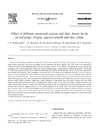Please use this identifier to cite or link to this item:
https://accedacris.ulpgc.es/jspui/handle/10553/1689
| DC Field | Value | Language |
|---|---|---|
| dc.contributor.author | Kalinowski Herrera, Carmen Tatiana | en_US |
| dc.contributor.author | Robaina, L. E. | en_US |
| dc.contributor.author | Fernández-Palacios, H. | en_US |
| dc.contributor.author | Schuchardt, Dominique | en_US |
| dc.contributor.author | Izquierdo, M. S. | en_US |
| dc.date.accessioned | 2009-10-08T02:31:00Z | |
| dc.date.accessioned | 2018-03-07T09:00:06Z | - |
| dc.date.available | 2018-03-07T09:00:06Z | - |
| dc.date.issued | 2005 | en_US |
| dc.identifier.issn | 0044-8486 | en_US |
| dc.identifier.other | Hosting | - |
| dc.identifier.uri | https://accedacris.ulpgc.es/handle/10553/1689 | - |
| dc.description.abstract | Whereas wild specimens exhibit a red pink silver colour, under captivity red porgy (Pagrus pagrus) skin turns dark grey, being directly associated with lower acceptance by the consumers and lower market value. This study was conducted to evaluate the effect of diet supplementation with two carotenoid sources, at two different concentrations, on growth and skin coloration. Fish of 44 g mean initial weight were fed the following diets: control (with no added carotenoids), CTX 40 and CTX100 (diets with 40 and 100 mg of synthetic canthaxanthin/kg); SM20 and SM40 (diets with 20 and 40 mg of astaxanthin from shrimp shell meal/kg). Three samplings were carried out in this study, at the beginning and after 75 and 105 days of feeding. At each sampling, individual weight and colour measurements were performed. Colour was evaluated in three different body zones: front lateral (zone I), front dorsal (zone II) and caudal fin (zone III). Growth was not influenced by the inclusion of carotenoids in red porgy diet. Only astaxanthin from shrimp shell meal, particularly at 40 mg/kg diet, was able to give red porgy skin an overall reddish coloration, suggesting a better utilization of astaxanthin from this source. Shrimp shell meal diets enhanced reddish hue and chroma values, nevertheless hue values at days 75 and 105 did not show a marked difference and chroma attained after 75 days of feeding time tended to be reduced at day 105, suggesting skin colour saturation after a certain feeding time. Carotenoid supplementation did not influence lightness of red porgy skin in the present experiment. From the three evaluated zones, zone I of fish fed SM40 diet presented lower hue, chroma and lightness variation; therefore, it could be proposed as a control zone for future studies. The results of this study suggests that the inclusion of astaxanthin, from shrimp shell meal, in red porgy commercial diets significantly improves skin coloration and markedly enhances the commercial value of this cultured species. | en_US |
| dc.language | eng | en_US |
| dc.relation | COLORED Q5RS-2000-31629 (UE) | en_US |
| dc.relation.ispartof | Aquaculture | en_US |
| dc.source | Aquaculture [ISSN 0044-8486], v. 244, p. 223-231 | en_US |
| dc.subject | Investigación | en_US |
| dc.subject.other | Bocinegro (Peces) | en_US |
| dc.subject.other | Alimentación | en_US |
| dc.subject.other | Carotenoides | en_US |
| dc.title | Effect of different carotenoid sources and their dietary levels on red porgy (Pagrus pagrus) growth and skin colour | en_US |
| dc.type | info:eu-repo/semantics/article | en_US |
| dc.type | Article | en_US |
| dc.identifier.doi | 10.1016/j.aquaculture.2004.11.001 | en_US |
| dc.identifier.scopus | 12744263205 | - |
| dc.contributor.authorscopusid | 16636905600 | - |
| dc.contributor.authorscopusid | 6603401174 | - |
| dc.contributor.authorscopusid | 6603285180 | - |
| dc.contributor.authorscopusid | 23390646100 | - |
| dc.contributor.authorscopusid | 7103111891 | - |
| dc.identifier.absysnet | 323300 | - |
| dc.identifier.crisid | -;47697;-;-;95 | |
| dc.description.lastpage | 231 | en_US |
| dc.description.firstpage | 223 | en_US |
| dc.relation.volume | 244 | en_US |
| dc.investigacion | Ciencias | en_US |
| dc.rights.accessrights | info:eu-repo/semantics/openAccess | es |
| dc.type2 | Artículo | en_US |
| dc.identifier.external | -;47697;-;-;95 | - |
| dc.identifier.external | -;47697;-;-;95 | - |
| dc.utils.revision | Sí | en_US |
| dc.identifier.supplement | -;47697;-;-;95 | - |
| dc.identifier.ulpgc | Sí | en_US |
| dc.description.jcr | 1,374 | |
| dc.description.jcrq | Q2 | |
| dc.description.scie | SCIE | |
| item.fulltext | Con texto completo | - |
| item.grantfulltext | open | - |
| crisitem.author.dept | GIR Grupo de Investigación en Acuicultura | - |
| crisitem.author.dept | IU de Investigación en Acuicultura Sostenible y Ec | - |
| crisitem.author.dept | Departamento de Biología | - |
| crisitem.author.dept | GIR Grupo de Investigación en Acuicultura | - |
| crisitem.author.dept | IU de Investigación en Acuicultura Sostenible y Ec | - |
| crisitem.author.dept | Departamento de Biología | - |
| crisitem.author.orcid | 0000-0003-4857-6693 | - |
| crisitem.author.orcid | 0000-0003-1410-8154 | - |
| crisitem.author.orcid | 0000-0003-4297-210X | - |
| crisitem.author.parentorg | IU de Investigación en Acuicultura Sostenible y Ec | - |
| crisitem.author.parentorg | IU de Investigación en Acuicultura Sostenible y Ec | - |
| crisitem.author.fullName | Robaina Robaina, Lidia Esther | - |
| crisitem.author.fullName | Fernández Palacios, Hipólito | - |
| crisitem.author.fullName | Izquierdo López, María Soledad | - |
| Appears in Collections: | Artículos | |
SCOPUSTM
Citations
156
checked on Jun 8, 2025
WEB OF SCIENCETM
Citations
130
checked on Jun 8, 2025
Page view(s)
126
checked on Oct 31, 2024
Download(s)
602
checked on Oct 31, 2024
Google ScholarTM
Check
Altmetric
Share
Export metadata
Items in accedaCRIS are protected by copyright, with all rights reserved, unless otherwise indicated.
